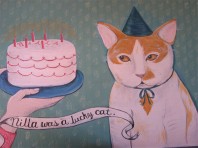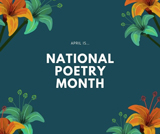When zinester/illustrator Nicole J. Georges was twenty-three, a psychic told her that her father was alive, big news to her after believing he was dead for most of her life. Georges tried her best to move on, but she struggled with the revelation. In a sudden act of desperation, she reached out to the conservative radio talk show host Dr. Laura, who she’d listened to with her mom while growing up. That one act spawned the compelling Calling Dr. Laura, Georges’s graphic memoir about her family and her attempts to succeed in relationships with little success in her past.
All of that aside, Georges has built herself a nice little empire in Portland where she publishes zines, draws pet portraits and teaches self-publishing and autobiographical comics to children and seniors. She was recently named one of 8 “worthy successors” to the incredible Alison Bechdel by Flavorwire, which said her memoir will appeal, not just to Bechdel fans but to anyone who “likes smart writing that packs an emotional punch.”
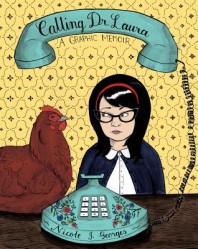
“. . . an engrossing, lovable, smart and ultimately poignant trip through a harrowing emotional bottleneck in family life. It’s great art, great writing, a great story- I can’t wait for what’s next from Nicole.”
—Rachel Maddow, MSNBC
LM: What made you decide now was the time to write your memoir?
NG: After writing a short story called “The Dr. Laura Show,” I received the opportunity to try and expand the story into a graphic memoir. It was a palm reader who revealed my family secret to me and started this whole mess, so I thought it would be appropriate to consult another psychic and ask if I should write the book now or wait. I had plenty to say on the subject, but the idea of delving into family history while my family members were still alive made me nervous. The psychic looked at my astrological chart, flipped tarot cards, and told me that if I was ever going to tell this story, the time was now, and that it would take me to a place, whether good or bad, I needed to go with my family. I think she was correct. The book itself took me into territory with my family that I otherwise would have let lay—at my own expense. It ushered in a new era of honesty and profoundly changed me.
LM: How do you think your family and friends will receive the book?
NG: My friends have been anticipating this book for a while, since I have been “finished” with it several times over the past few years. They’ve taken me out for drinks to celebrate, only to find out that in fact it was not finished. My family has been 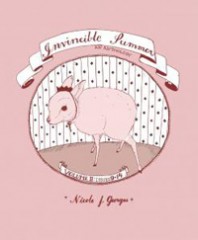 supportive, meaning they know that “the dad thing” was such a huge, unique and jarring experience and they respect me dealing with it however I can. When I contacted my ex-girlfriend who is in the book, she expressed that she was proud of me for telling the truth. Ultimately, I balm my own anxiety with the fact that with this book came honesty, forgiveness, and control over my own narrative.
supportive, meaning they know that “the dad thing” was such a huge, unique and jarring experience and they respect me dealing with it however I can. When I contacted my ex-girlfriend who is in the book, she expressed that she was proud of me for telling the truth. Ultimately, I balm my own anxiety with the fact that with this book came honesty, forgiveness, and control over my own narrative.
LM: What has been more difficult: writing such a personal story about your life or now having to talk about it?
NG: I think writing a personal story about my life was much harder than having to talk about it. Graphic novels take so long to create. Basically I was reliving a break-up and the most sensitive, hidden stories from my past for months at a time as I wrote, drew, and redrew each page. It was like slipping on the Lord of the Rings ring, I just had this cloud around me as I dredged it up and transformed it into something different, something that I could be honest and proud of.
LM: So would you say it was pretty therapeutic?
NG: I would say it was pretty therapeutic. I knew I was biting off something large when I started this project, both emotionally and drawing-wise, but it surpassed even those expectations by revealing new truths, new family members, and the capacity for everyone in my family to grow, forgive and change. Myself included.
LM: So how do you know when you’ve written something that is good?
NG: If something makes me really uncomfortable to write, or makes me emotional going back and reading it, then I know that it will have some sort of impact on readers. It was actually a lot harder with this book to gauge how things were going, because I was not getting that same immediate feedback and satisfaction that I usually 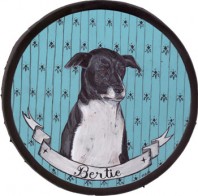 get from putting something short out within months of drawing it. This book took two years before every piece was drawn enough to even be able to show it to people from beginning to end. I had 18 months of edits and additions after that. It was really nice to work with insightful editors in this process, because they helped me realize when I was taking too much for granted and leaving out details that may help readers along.
get from putting something short out within months of drawing it. This book took two years before every piece was drawn enough to even be able to show it to people from beginning to end. I had 18 months of edits and additions after that. It was really nice to work with insightful editors in this process, because they helped me realize when I was taking too much for granted and leaving out details that may help readers along.
LM: I’m always amazed with the skill that goes into maintaining flow in graphic novels/memoirs. Between the illustrations, dialogue bubbles, thought bubbles, and narration, there is so much happening on a page. I love seeing how illustrators guide readers along. And lastly, do you autograph people’s books with drawings? Because that is the best.
NG: I do! I just started doing that officially after receiving the thrill of a drawn autograph in a book by Gabrielle Bell. I think it’s a really special thing that cartoonists can offer, so I am happy to do it. It’s also more fun than having to think of something to say, like “Thank You For Buying This Book” or “Yours Truly, NG.”
Seattle readers, catch Georges and her autograph at Elliott Bay Book Company January 30 at 8pm.
Lindsey McGuirk is Village Books’ Digital Marketing & Publishing Coordinator. She also handles the store’s online marketing and works with authors to get their books published on the print-on-demand Espresso Book Machine.

